Flowering Dogwood
- October 17, 2023
- 0 comment
Flowering Dogwood (Cornus florida) is a beloved deciduous tree native to eastern North America, renowned for its stunning springtime display of delicate, four-petaled, white or pink flowers that create a beautiful contrast against its dark green leaves. This iconic tree can reach heights of 15 to 30 feet and has a distinctive flat-topped crown.
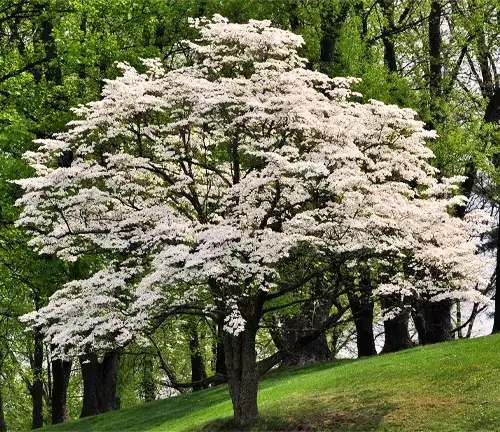

Flowering Dogwoods are not just appreciated for their aesthetic appeal; they also play a vital ecological role, providing food for various wildlife, such as birds and squirrels, and serving as host plants for the larvae of butterflies. In autumn, the tree’s foliage turns vibrant shades of red, adding to its year-round charm.
With its ornamental beauty and ecological significance, the Flowering Dogwood has earned a special place in the hearts of nature enthusiasts and gardeners alike.
| Characteristics | Description |
| Scientific Name | Cornus florida |
| Common Names | Flowering Dogwood, Eastern Dogwood |
| Family | Cornaceae |
| Type | Deciduous tree |
| Height | 15 to 30 feet (4.5 to 9 meters) |
| Leaves | Dark green, elliptical, opposite arrangement |
| Flowers | Four-petaled, white or pink, in clusters |
| Bloom Time | Spring (April to May) |
| Fruit | Red berry-like drupes |
| Bark | Grayish-brown with blocky texture |
| Fall Foliage | Vibrant shades of red |
| Native Range | Eastern North America |
| Ecological Role | Provides food for birds and squirrels, host plant for butterfly larvae |
| Lifespan | Typically 30 to 40 years, but can live longer with proper care |
| Growth Rate | Slow to moderate |
| Preferred Soil | Well-draining, acidic to neutral |
| Light Requirements | Partial shade to full sun |
| USDA Hardiness Zones | 5 to 9 |
| Landscaping Use | Ornamental tree, woodland gardens, naturalized areas |
Botanical Beauty of “Flowering Dogwood”
The Flowering Dogwood (Cornus florida) is a true emblem of natural beauty in eastern North America. This captivating deciduous tree, also known as Eastern Dogwood, graces the landscape with its enchanting presence. With its delicate, four-petaled blossoms, it’s no wonder that this tree has captured the hearts of many. In this article, we explore the botanical beauty and the various facets of this iconic tree that make it a cherished symbol of nature.
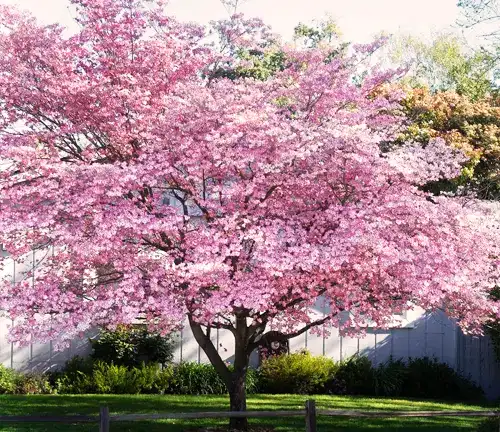
Woodland Elegance
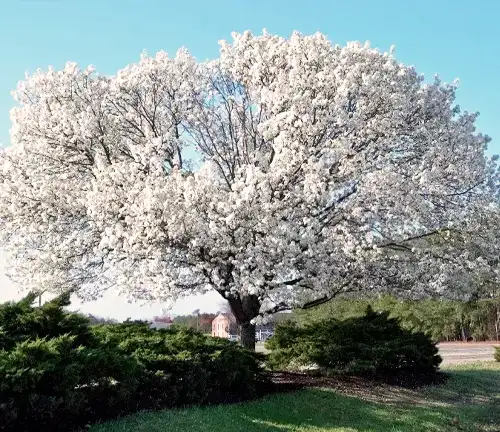
The Flowering Dogwood is often found in the dappled sunlight of eastern North American woodlands, adding a touch of elegance to these serene environments. Its dark green, elliptical leaves provide a lush canopy, offering respite to those who seek shelter beneath it. While the Dogwood’s branches stretch towards the sky, they gracefully form a flat-topped crown, which adds to the tree’s picturesque charm. Its distinctive shape sets it apart from other trees, making it instantly recognizable and admired.
Ecological Importance
Beyond its aesthetic appeal, Flowering Dogwoods play a vital role in supporting local ecosystems. Birds and squirrels are particularly fond of the tree’s red berry-like drupes, making it a crucial source of sustenance. But it’s not just the animals that benefit; the Dogwood also serves as a host plant for butterfly larvae. By nurturing these tiny creatures, the tree aids in pollination and contributes to the overall health of the ecosystem. In this way, the Flowering Dogwood showcases the intricate web of connections that sustain life in the wild.

Cultivation and Conservation
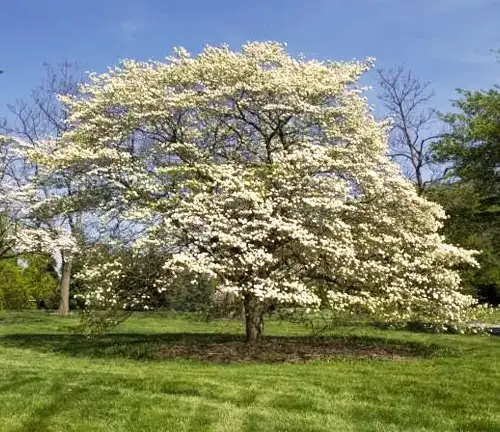
For those looking to bring the beauty of Flowering Dogwoods into their own landscapes, understanding their cultivation is essential. These trees prefer well-draining, acidic to neutral soils and can thrive in partial shade to full sun. With their moderate growth rate and potential lifespan of 30 to 40 years (or more with proper care), they can be a lasting addition to any garden. However, it’s essential to approach cultivation with conservation in mind. Many Dogwood populations face threats from habitat loss and disease, making the protection of these trees a priority.
Fragrance
One of the hidden treasures of the Flowering Dogwood is its delicate fragrance. When in full bloom during spring (typically April to May), the tree exudes a sweet, mild scent that wafts through the air. It’s a sensory delight that adds another layer of appeal to this natural wonder. The aroma is often associated with the arrival of warmer, sunnier days, making it a herald of the changing seasons.
Soil Stabilization
Beyond its visual and olfactory charms, the Flowering Dogwood plays a more utilitarian role. Its extensive root system helps with soil stabilization. This is especially crucial in woodland environments, where erosion can be a significant concern. The roots of the Dogwood hold the soil in place, preventing it from washing away during heavy rains and contributing to the overall health of the ecosystem.
Common Uses
The Flowering Dogwood is not just a sight to behold in the wild; it’s also a popular choice in landscaping. Its ornamental beauty and adaptability make it a favorite for woodland gardens and naturalized areas. When planted strategically, it can provide an attractive backdrop for other garden plants while attracting local wildlife.
Benefits
The benefits of the Flowering Dogwood are multifold. Its blossoms enchant us in spring, and its autumn foliage captivates us with vibrant red hues. Ecologically, it supports local wildlife and aids in soil stabilization. In gardens, it serves as a stunning ornamental choice. Beyond these aspects, its sheer existence reminds us of the intricate relationships that underpin the natural world. The Flowering Dogwood is not merely a tree; it’s a symbol of our connection to nature and a testament to the wonder that can be found in the simplest of things.

Different Species
Kousa Dogwood
(Cornus kousa)
Native to East Asia, the Kousa Dogwood is known for its unique pointed petals and attractive, strawberry-like fruit. It blooms later than the Flowering Dogwood, typically in late spring to early summer.
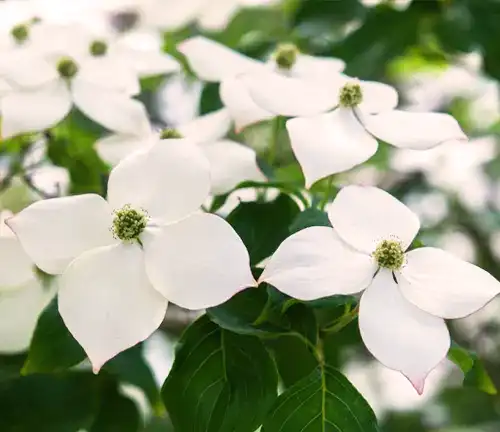
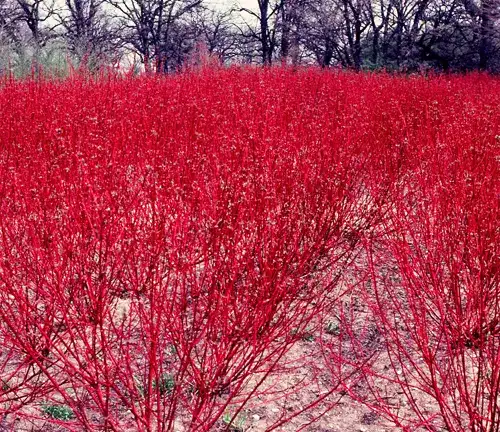
Red Osier Dogwood
(Cornus sericea)
This species is native to North America and is characterized by its red stems, especially prominent in winter. While not known for its flowers, it is valued for its colorful bark and its use in natural landscaping and erosion control.
Cornelian Cherry
(Cornus mas)
Native to Europe and Asia, this dogwood species produces small, bright yellow flowers in late winter or early spring. It is known for its edible red berries, which are often used to make jams and preserves.
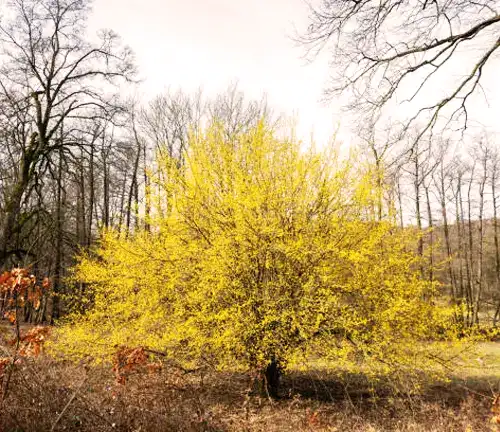
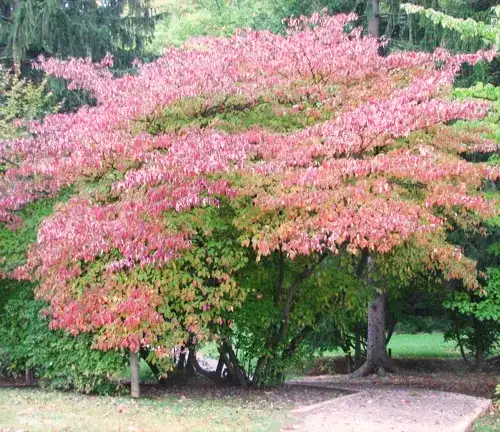
Pagoda Dogwood
(Cornus alternifolia)
Native to eastern North America, the Pagoda Dogwood is a smaller, multi-stemmed tree. It is noted for its tiered branches and clusters of small, creamy white flowers in spring, followed by dark blue-black berries.
Silky Dogwood
(Cornus amomum)
Native to North America, the Silky Dogwood is a deciduous shrub with creamy white flowers in late spring and early summer. It’s often found in wetland areas and is valued for its ability to control erosion.

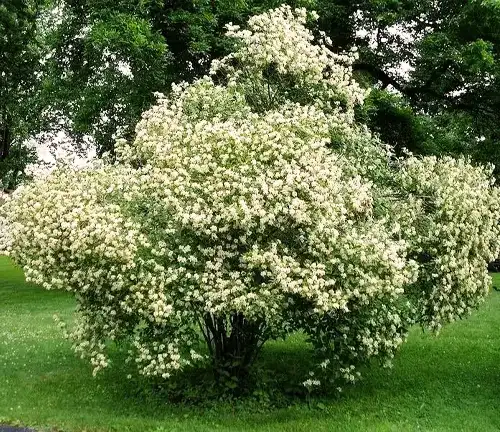
Gray Dogwood
(Cornus racemosa)
Another North American species, the Gray Dogwood produces clusters of white flowers in late spring and is also used for its ability to stabilize soil in natural landscapes.
Frequently Asked Questions (FAQs)
- What is a Flowering Dogwood?
Flowering Dogwood (Cornus florida) is a deciduous tree native to eastern North America, known for its showy, four-petaled flowers and vibrant red berries. - When do Flowering Dogwoods bloom?
Flowering Dogwoods typically bloom in spring, with their iconic white or pink flowers appearing in April to May. - What are the different varieties of Flowering Dogwoods?
There are several cultivars and varieties of Flowering Dogwood, with variations in flower color, size, and growth habit. Some popular ones include “Cherokee Brave” and “Cherokee Princess.” - What are the ideal growing conditions for Flowering Dogwoods?
Flowering Dogwoods thrive in well-draining, acidic to neutral soil and can grow in partial shade to full sun. They are best suited for USDA Hardiness Zones 5 to 9. - How do I care for a Flowering Dogwood tree?
Regular watering, mulching, and proper pruning to remove dead or diseased branches are essential. They may benefit from occasional fertilization, but be careful not to over-fertilize. - Do Flowering Dogwoods have any pest or disease issues?
Flowering Dogwoods are susceptible to diseases like dogwood anthracnose and powdery mildew. They can also face pest problems like scale insects and borers. - What is the lifespan of a Flowering Dogwood tree?
Flowering Dogwoods typically live for 30 to 40 years, although with proper care, they can live longer. - Are Flowering Dogwoods attractive to wildlife?
Yes, Flowering Dogwoods are known to attract birds and squirrels with their red berries. They also serve as host plants for butterfly larvae. - Can I grow Flowering Dogwoods in a container or as a small ornamental tree?
While Flowering Dogwoods are typically larger trees, there are dwarf and compact varieties suitable for growing in containers or as smaller ornamental trees. - Are Flowering Dogwoods endangered or at risk?
Flowering Dogwoods in some areas face threats from habitat loss and diseases like dogwood anthracnose, but their conservation status varies by region. - Do Flowering Dogwoods have any cultural significance or symbolism?
Yes, Flowering Dogwoods have cultural and symbolic importance in various Native American and regional traditions. They are often associated with rebirth and renewal.


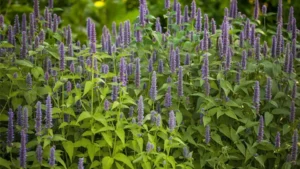
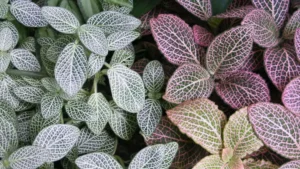

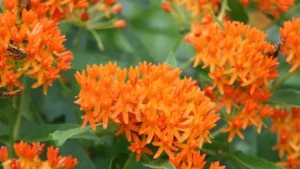
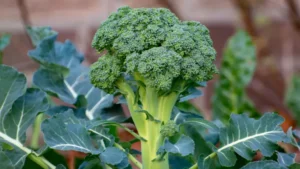

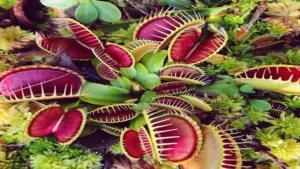
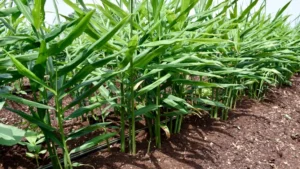

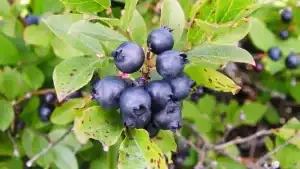
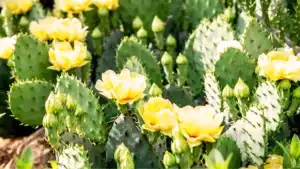
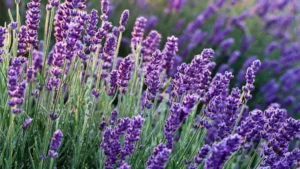
Leave your comment